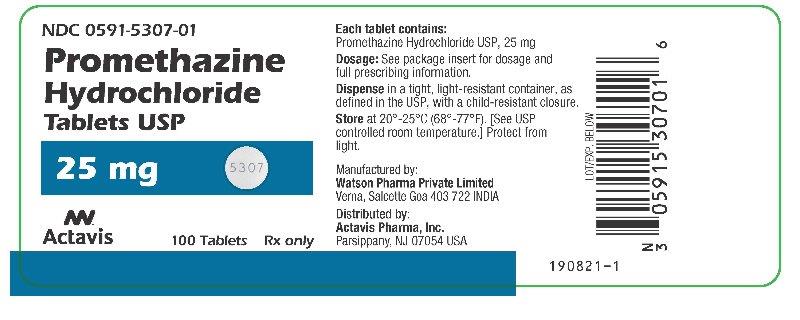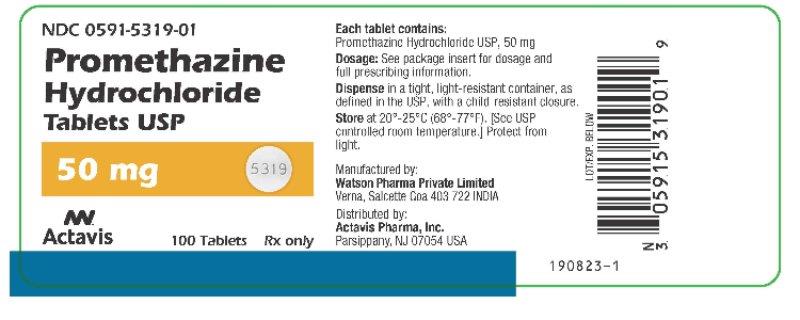Drug Catalog - Product Detail
PROMETHAZINE HCI TB 25MG 100
| NDC | Mfr | Size | Str | Form |
|---|---|---|---|---|
| 00591-5307-01 | ACTAVIS PHARMA | 100 | 25MG | TABLET |
PACKAGE FILES



Generic Name
PROMETHAZINE HYDROCHLORIDE
Substance Name
PROMETHAZINE HYDROCHLORIDE
Product Type
HUMAN PRESCRIPTION DRUG
Route
ORAL
Application Number
ANDA083426
Description
DESCRIPTION Promethazine hydrochloride is a racemic compound. Promethazine hydrochloride, a phenothiazine derivative, is designated chemically as 10 H -Phenothiazine-10-ethanamine, N, N ,α-trimethyl-, monohydrochloride, (±)- with the following structural formula: C 17 H 20 N 2 S•HCl M.W. 320.88 Promethazine hydrochloride occurs as a white to faint yellow, practically odorless, crystalline powder which slowly oxidizes and turns blue on prolonged exposure to air. It is soluble in water and freely soluble in alcohol. Each tablet, for oral administration, contains 25 mg or 50 mg of promethazine hydrochloride. In addition each tablet contains the following inactive ingredients: dibasic calcium phosphate, magnesium stearate, microcrystalline cellulose, sodium starch glycolate and stearic acid. Promethazine Hydrochloride Tablets USP, 50 mg also contain anhydrous lactose. Promethazine HCl Structural Formula
How Supplied
HOW SUPPLIED Promethazine Hydrochloride Tablets USP, 25 mg are scored, round, white tablets imprinted DAN DAN and 5307 supplied in bottles of 100 and 1000. Promethazine Hydrochloride Tablets USP, 50 mg are unscored, round, white tablets imprinted DAN and 5319 supplied in bottles of 100. Dispense in a tight, light-resistant container as defined in the USP, with a child-resistant closure. Keep tightly closed. Store at 20-25°C (68-77°F). [See USP controlled room temperature.] Protect from light. Manufactured by: Watson Pharma Private Ltd. Verna, Salcette Goa 403 722 INDIA Distributed by: Actavis Pharma, Inc. Parsippany, NJ 07054 USA Revised: December 2016 190824-1
Indications & Usage
INDICATIONS AND USAGE Promethazine hydrochloride tablets are useful for: Perennial and seasonal allergic rhinitis. Vasomotor rhinitis. Allergic conjunctivitis due to inhalant allergens and foods. Mild, uncomplicated allergic skin manifestations of urticaria and angioedema. Amelioration of allergic reactions to blood or plasma. Dermographism. Anaphylactic reactions, as adjunctive therapy to epinephrine and other standard measures, after the acute manifestations have been controlled. Preoperative, postoperative, or obstetric sedation. Prevention and control of nausea and vomiting associated with certain types of anesthesia and surgery. Therapy adjunctive to meperidine or other analgesics for control of post-operative pain. Sedation in both children and adults, as well as relief of apprehension and production of light sleep from which the patient can be easily aroused. Active and prophylactic treatment of motion sickness. Antiemetic therapy in postoperative patients.
Dosage and Administration
DOSAGE AND ADMINISTRATION Promethazine Hydrochloride Tablets USP are contraindicated for children under 2 years of age (see WARNINGS-Black Box Warning and Use in Pediatric Patients ). Allergy The average oral dose is 25 mg taken before retiring; however, 12.5 mg may be taken before meals and on retiring, if necessary. Single 25-mg doses at bedtime or 6.25 to 12.5 mg taken three times daily will usually suffice. After initiation of treatment in children or adults, dosage should be adjusted to the smallest amount adequate to relieve symptoms. The administration of promethazine HCl in 25-mg doses will control minor transfusion reactions of an allergic nature. Motion Sickness The average adult dose is 25 mg taken twice daily. The initial dose should be taken one-half to one hour before anticipated travel and be repeated 8 to 12 hours later, if necessary. On succeeding days of travel, it is recommended that 25 mg be given on arising and again before the evening meal. For children, promethazine hydrochloride tablets, syrup, or rectal suppositories, 12.5 to 25 mg twice daily, may be administered. Nausea and Vomiting Antiemetics should not be used in vomiting of unknown etiology in children and adolescents (see WARNINGS-Use in Pediatric Patients ). The average effective dose of promethazine hydrochloride for the active therapy of nausea and vomiting in children or adults is 25 mg. When oral medication cannot be tolerated, the dose should be given parenterally (cf. Promethazine Injection) or by rectal suppository. 12.5- to 25-mg doses may be repeated, as necessary, at 4- to 6-hour intervals. For nausea and vomiting in children, the usual dose is 0.5 mg per pound of body weight, and the dose should be adjusted to the age and weight of the patient and the severity of the condition being treated. For prophylaxis of nausea and vomiting, as during surgery and the postoperative period, the average dose is 25 mg repeated at 4- to 6-hour intervals, as necessary. Sedation This product relieves apprehension and induces a quiet sleep from which the patient can be easily aroused. Administration of 12.5 to 25 mg promethazine hydrochloride by the oral route or by rectal suppository at bedtime will provide sedation in children. Adults usually require 25 to 50 mg for nighttime, presurgical, or obstetrical sedation. Pre- and Postoperative Use Promethazine hydrochloride in 12.5- to 25-mg doses for children and 50-mg doses for adults the night before surgery relieves apprehension and produces a quiet sleep. For preoperative medication, children require doses of 0.5 mg per pound of body weight in combination with an appropriately reduced dose of narcotic or barbiturate and the appropriate dose of an atropine-like drug. Usual adult dosage is 50 mg promethazine HCl with an appropriately reduced dose of narcotic or barbiturate and the required amount of a belladonna alkaloid. Postoperative sedation and adjunctive use with analgesics may be obtained by the administration of 12.5 to 25 mg in children and 25- to 50-mg doses in adults. Promethazine hydrochloride tablets are contraindicated for children under 2 years of age.
